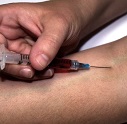
February 27, 2024
The Ontario Poison Centre is aware of pharmaceutically active substance contamination in the illicit drug supply in Ontario and Manitoba. Of note, in the recent past, xylazine, dexmedetomidine, and metomidine have been detected in the supply. These substances are all alpha2 agonists. They act at receptors in the Central Nervous System to decrease sympathetic outflow. The resulting symptoms include depressed level of awareness, mild hypotension and bradycardia. As these substances are often found in the opioid supply, the expected respiratory depression, and other symptoms already known to occur from opioids are likely to be exacerbated.
The opioid toxidrome can be reversed by using naloxone. As opioid withdrawal can be precipitated by the use of naloxone, it is suggested that doses of naloxone for the depressed patient suspected of having been exposed to illicit drug supply, start low and be escalated slowly if respiratory rate and oxygen saturation are not improved. Classically, usual opioids are very responsive to naloxone. Some of the designer opioids (carfentanyl and others) may require higher doses. The maximum dose to be given should be no more than 10-12 mg. Should there be an incomplete response or should the patient not respond to the maximum dose, then there is no further benefit to additional naloxone. Should a patient have a good response but become depressed again, the wakeup dose can be repeated or an infusion started.
The alpha2 agonists do NOT respond to naloxone. Should the patient have inadequate response to naloxone, then the usual supportive care must be maintained until these medications are metabolized & eliminated. This may include intubation, oxygenation, ventilation, and blood pressure support beyond intravenous fluids.
Flumazenil is never indicated. The alpha2 agonists do NOT interact at the GABA receptors. Many illicit drugs are also contaminated with benzodiazepines. Chronic use of illicit opioids equals chronic use of benzodiazepines to the unsuspecting consumer. These patients are also now benzodiazepine dependent. Flumazenil will precipitate acute benzodiazepine withdrawal increasing the likelihood that these patients will seize.
Call the Ontario Poison Centre for specific care for your patient.
Margaret Thompson, MD, FRCPC
Medical Director, Ontario & Manitoba Poison Centres
Across Canada, deaths from the direct effect of opioid drugs have escalated over the last several years. Many new potent opioids, including fentanyl and its analogues, are available on the streets. These may be used as substitutes for heroin and cocaine, or found as contaminants of these drugs. Even those who use opioids regularly may not be tolerant to these relatively potent opioids, resulting in unexpected overdoses. The opioid known as carfentanil is an example of a fentanyl analogue.
Opioids typically cause a person to have a depressed level of consciousness, a decreased respiratory rate and small or pinpoint, pupils. With increasing intoxication, respirations can stop, and further injury from hypoxia, including coma and cardiac arrest, can occur.